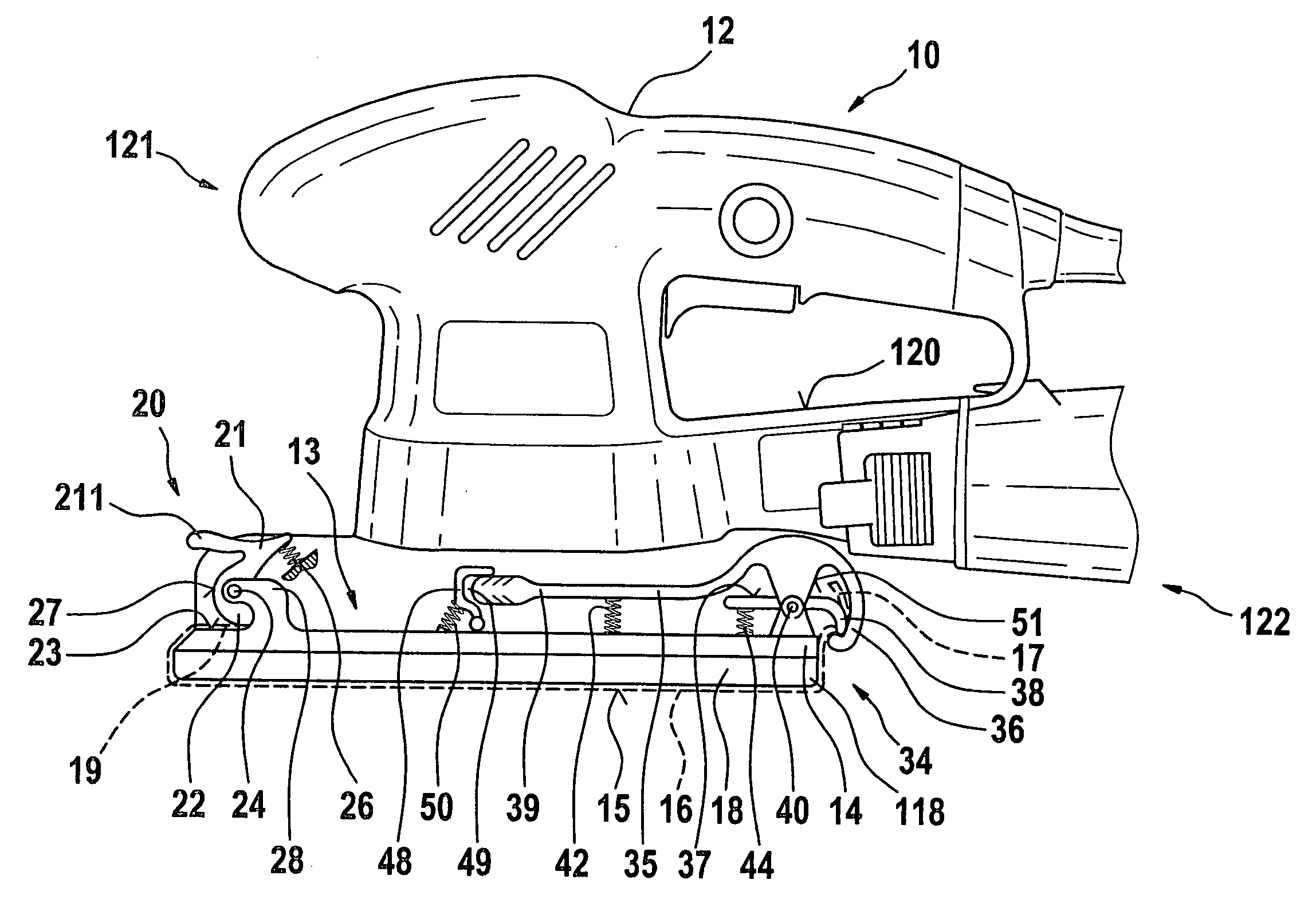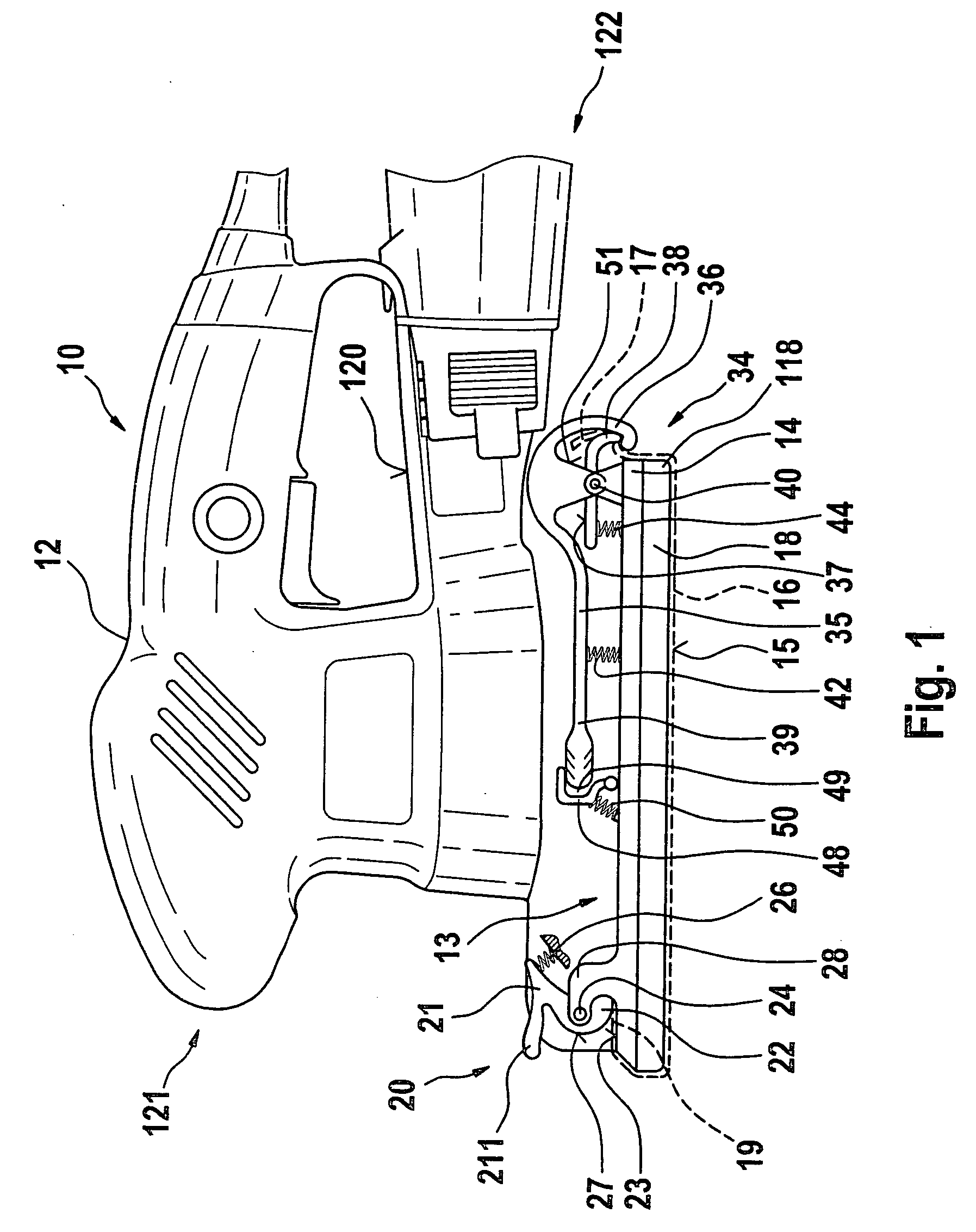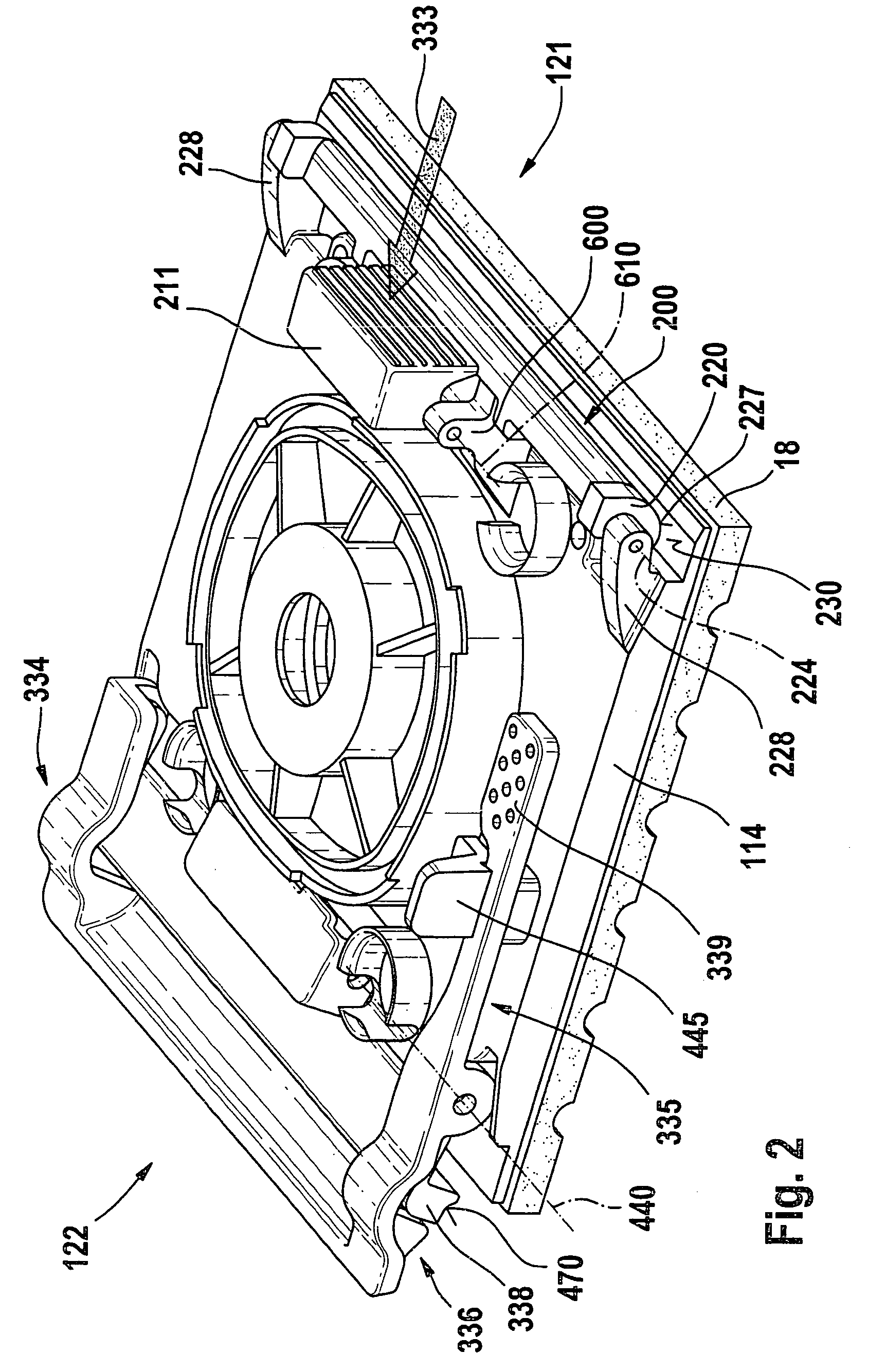[0006] The manual
grinding tool according to the present invention having the characterizing features of claim 1 has the
advantage of particularly convenient, rapid clamping—combined with the abrasive sheet being stretched tight—using only one hand, with simplified manufacture of the clamping means at lower cost and significant weight reduction. This results in increased abrasive performance and greater
overall efficiency of the manual grinding tool.
[0007] Due to the fact that the first abrasive sheet end is capable of being inserted using just one hand into a self-opening slit and is automatically clampable there, and, subsequently, the second abrasive sheet end is insertable—also using just one hand—into the clamping device and is then capable of being stretched tight, to the tearing limit, the abrasive sheet is capable of being fixed quickly and safely against misuse between the two clamping points and the working surface of the abrasive sheet carrier in such a manner that it is stretched tightly and, during sanding, a
relative motion between the abrasive sheet carrier and the abrasive sheet is largely prevented.
[0008] Due to the fact that the slit which clamps the first abrasive sheet end is opened using a single, central, easily located operating button to release the abrasive sheet, the operating comfort of the manual grinding tool is particularly high.
[0009] Due to the fact that one of the clamping means is configured as tongs, between the clamping jaws of which an abrasive sheet end is clampable, and due to the fact that the tongs—together with the clamped abrasive sheet end—are movable around a swivel axis and are lockable in an end position, secure clamping followed by stretching-tight of the abrasive sheet is attainable in a convenient and reliable manner using simple means.
[0010] The tongs have the
advantage that abrasive sheets of any thickness are clampable with maximum clamping force, because a long closing path enables all dimensional differences to be compensated for in a sensitive manner, whereby the clamping force attained is stronger than has been previously achieved. In addition, abrasive sheets having different lengths—within limits—can be installed on the hand
power tool, because a long overhang can easily form between the open active clamping jaw—configured in the shape of a half ring or bracket—and the passive clamping jaw, and it can be comfortably accommodated there.
[0016] Due to the fact that the active clamping jaw is bent in the manner of a half ring and grips around the passive clamping jaw in such a manner that it rests against the outside of the passive clamping jaw to clamp the abrasive sheet and carries it along when pivoted into the clamped position, a user-friendly clamping-tightening mechanism with
reduced risk of injury when replacing the abrasive sheet and / or working with the manual grinding tool is created, because protruding edges on the manual grinding tool are prevented. A defined spring load-deflection curve of the active clamping jaw is achieved via its bracket or arch-shaped configuration having a certain wire
diameter, so that a maximum clamping force between the clamping jaws is established in the clamped position.
[0018] Due to the fact that, in addition to the tongs for the one abrasive sheet end, clamping means for the other abrasive sheet end are provided, which said clamping means act in a manner such that they allow the abrasive sheet to enter in a preferred direction, but release in the reverse direction with special actuation, it is possible to clamp the abrasive sheet quickly using just one hand.
[0003] The operator must use both hands to clamp the abrasive sheets in place, and the hand
power tool should be placed on a
solid surface. Using one hand, one end of the abrasive sheet is inserted into a slit between an opened clamping jaw and the top side of the abrasive sheet carrier, and the clamping jaw is held open in the release position until the end of the abrasive sheet is inserted so that it closes via
spring force when the clamping jaw is released. This is the clamped position in which the abrasive sheet end is fixed. The abrasive sheet is automatically tightened to a certain extent in that the rotatably mounted clamping jaw tries to roll away from the abrasive sheet end, thereby carrying it along, due to an inclined-plane contact surface on the top side of the abrasive sheet carrier.
[0007] Due to the fact that the first abrasive sheet end is capable of being inserted using just one hand into a self-opening slit and is automatically clampable there, and, subsequently, the second abrasive sheet end is insertable—also using just one hand—into the clamping device and is then capable of being stretched tight, to the tearing limit, the abrasive sheet is capable of being fixed quickly and safely against misuse between the two clamping points and the working surface of the abrasive sheet carrier in such a manner that it is stretched tightly and, during sanding, a
relative motion between the abrasive sheet carrier and the abrasive sheet is largely prevented.
[0007] Due to the fact that the first abrasive sheet end is capable of being inserted using just one hand into a self-opening slit and is automatically clampable there, and, subsequently, the second abrasive sheet end is insertable—also using just one hand—into the clamping device and is then capable of being stretched tight, to the tearing limit, the abrasive sheet is capable of being fixed quickly and safely against misuse between the two clamping points and the working surface of the abrasive sheet carrier in such a manner that it is stretched tightly and, during sanding, a
relative motion between the abrasive sheet carrier and the abrasive sheet is largely prevented.
[0016] Due to the fact that the active clamping jaw is bent in the manner of a half ring and grips around the passive clamping jaw in such a manner that it rests against the outside of the passive clamping jaw to clamp the abrasive sheet and carries it along when pivoted into the clamped position, a user-friendly clamping-tightening mechanism with
reduced risk of injury when replacing the abrasive sheet and / or working with the manual grinding tool is created, because protruding edges on the manual grinding tool are prevented. A defined spring load-deflection curve of the active clamping jaw is achieved via its bracket or arch-shaped configuration having a certain wire
diameter, so that a maximum clamping force between the clamping jaws is established in the clamped position.
[0020] Due to the fact that the clamping jaws are composed of elastic, rubber-like material, the clamping
servo effect becomes stronger as the clamping of the abrasive sheet increases. This
servo effect is also strengthened by the fact that the outer contour of the clamping jaw is bent progressively with a small variation in
pitch.
[0018] Due to the fact that, in addition to the tongs for the one abrasive sheet end, clamping means for the other abrasive sheet end are provided, which said clamping means act in a manner such that they allow the abrasive sheet to enter in a preferred direction, but release in the reverse direction with special actuation, it is possible to clamp the abrasive sheet quickly using just one hand.
[0019] In this case, one-hand operation means that, in fact, only one hand need be active to insert and fix the abrasive sheet. The other hand can be used alone to fix the hand power tool, e.g., to press it against a base.
[0020] Due to the fact that the clamping jaws are composed of elastic, rubber-like material, the clamping
servo effect becomes stronger as the clamping of the abrasive sheet increases. This servo effect is also strengthened by the fact that the outer contour of the clamping jaw is bent progressively with a small variation in
pitch.
[0021] Due to the fact that the clamping jaws are composed of sheet
metal and / or wire and are provided with a rubber
coating, they are easy-to-manufacture, lightweight and functionally reliable.
[0009] Due to the fact that one of the clamping means is configured as tongs, between the clamping jaws of which an abrasive sheet end is clampable, and due to the fact that the tongs—together with the clamped abrasive sheet end—are movable around a swivel axis and are lockable in an end position, secure clamping followed by stretching-tight of the abrasive sheet is attainable in a convenient and reliable manner using simple means.
[0023] Due to the fact that the clamping jaw is positioned horizontally and the
insertion slit must be opened wide—whereby it can even lie below the plane of the sanding plate—the abrasive sheet need not be angled upward or bent to be inserted into the slit; instead, it can be inserted in a self-locating, extremely convenient—“blindly”, even—very casual manner, and then stretched tight.
 Login to View More
Login to View More  Login to View More
Login to View More 


